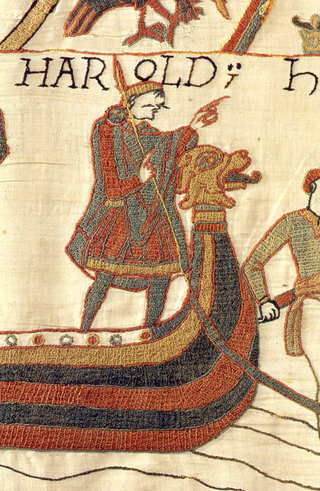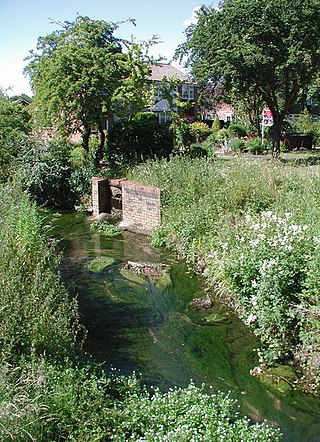Related Research Articles

The Bayeux Tapestry is an embroidered cloth nearly 70 metres long and 50 centimetres tall that depicts the events leading up to the Norman Conquest of England in 1066, led by William, Duke of Normandy challenging Harold II, King of England, and culminating in the Battle of Hastings. It is thought to date to the 11th century, within a few years of the battle. Now widely accepted to have been made in England, perhaps as a gift for William, it tells the story from the point of view of the conquering Normans and for centuries has been preserved in Normandy.
The bliaut or bliaud is an overgarment that was worn by both sexes from the eleventh to the thirteenth century in Western Europe, featuring voluminous skirts and horizontal puckering or pleating across a snugly fitted under bust abdomen. The sleeves are the most immediately notable difference when comparing the bliaut to other female outer clothing of the Middle Ages. They fit closely from the shoulder to approximately the elbow, and then widen from the elbow to drape to floor- or nearly floor-length. This garment's usage appears to be geographically limited to areas of French influence, with some works depicting the garment or the garment in transition as far away as Rome and modern Germany.

Anglo-Saxon dress refers to the clothing and accessories worn by the Anglo-Saxons from the middle of the fifth century to the eleventh century. Archaeological finds in Anglo-Saxon cemeteries have provided the best source of information on Anglo-Saxon costume. It is possible to reconstruct Anglo-Saxon dress using archaeological evidence combined with Anglo-Saxon and European art, writing and literature of the period. Archaeological finds have both supported and contradicted the characteristic Anglo-Saxon costume as illustrated and described by these contemporary sources.

Early medieval European dress, from about 400 AD to 1100 AD, changed very gradually. The main feature of the period was the meeting of late Roman costume with that of the invading peoples who moved into Europe over this period. For a period of several centuries, people in many countries dressed differently depending on whether they identified with the old Romanised population, or the new populations such as Franks, Anglo-Saxons, Visigoths. The most easily recognisable difference between the two groups was in male costume, where the invading peoples generally wore short tunics, with belts, and visible trousers, hose or leggings. The Romanised populations, and the Church, remained faithful to the longer tunics of Roman formal costume, coming below the knee, and often to the ankles. By the end of the period, these distinctions had finally disappeared, and Roman dress forms remained mainly as special styles of clothing for the clergy – the vestments that have changed relatively little up to the present day.

Shot silk is a fabric which is made up of silk woven from warp and weft yarns of two or more colours producing an iridescent appearance. A "shot" is a single throw of the bobbin that carries the weft thread through the warp, and shot silk colours can be described as "[warp colour] shot with [weft colour]." The weaving technique can also be applied to other fibres, such as cotton, linen, and synthetics.

English embroidery includes embroidery worked in England or by English people abroad from Anglo-Saxon times to the present day. The oldest surviving English embroideries include items from the early 10th century preserved in Durham Cathedral and the 11th century Bayeux Tapestry, if it was worked in England. The professional workshops of Medieval England created rich embroidery in metal thread and silk for ecclesiastical and secular uses. This style was called Opus Anglicanum or "English work", and was famous throughout Europe.

The Bayeux Tapestry tituli are Medieval Latin captions that are embroidered on the Bayeux Tapestry and describe scenes portrayed on the tapestry. These depict events leading up to the Norman conquest of England concerning William, Duke of Normandy, and Harold, Earl of Wessex, later King of England, and culminating in the Battle of Hastings.
Æthelwynn, often spelled Ethylwynn, Ethylwyn, or Ethelwynn (10th-century) was an English noblewoman and textile artist. She was known for her embroidery work and her miraculous encounter with Saint Dunstan.

Welbeck Hill is the site of Roman and early Saxon pottery finds, and an Anglo-Saxon cemetery, located around 1.75 miles from Laceby, and around 3 miles from Riby, in North East Lincolnshire, England.

Wynflæd or Ƿynflæd was an Anglo-Saxon noblewoman and a major landowner in the areas of Hampshire, Somerset, Dorset and Wiltshire. Wynflæd is likely a widow vowess primarily connected to royal foundation at Shaftesbury Abbey, with further connections to royal nunnery at Wilton Abbey. There is ongoing debate if she was the mother of Aelfgifu of Shaftesbury and thus the grandmother of Kings Eadwig and Edgar the Peaceful.
John D. Niles is an American scholar of medieval English literature best known for his work on Beowulf and the theory of oral literature.
Helen Damico was a Greek-born American scholar of Old English and Old English literature.
Jane Chance, also known as Jane Chance Nitzsche, is an American scholar specializing in medieval English literature, gender studies, and J. R. R. Tolkien. She spent most of her career at Rice University, where since her retirement she has been the Andrew W. Mellon Distinguished Professor Emerita in English.

Anglo-Saxon brooches are a large group of decorative brooches found in England from the fifth to the eleventh centuries. In the early Anglo-Saxon era, there were two main categories of brooch: the long (bow) brooch and the circular (disc) brooch. The long brooch category includes cruciform, square-headed, radiate-headed, and small-long brooch brooches. The long brooches went out of fashion by the end of the sixth century.
Haruko Momma is a philologist and a scholar of Old English literature and language. She has published on Old English poetic composition, Beowulf, philology in the nineteenth century, and teaching Old English. She is currently Professor of English at New York University.
Quita Mould is an archaeologist, specialising in small finds and the identification of leather.
Anna Grace Ida Christie (1872–1953) was an English embroiderer, teacher and historian of embroidery who published a comprehensive work on opus anglicanum in 1938, documenting every known example. "She is regarded as one of the most influential people in the early twentieth century with respect to the development of embroidery and embroidery studies in Britain and elsewhere."
Antonette diPaolo Healey is a philologist and a scholar of Old English literature and language. She has published on lexicography, glossography, and history of the English language. diPaolo Healey edited seven releases of The Dictionary of Old English (DOE), overseeing the development of the dictionary from physical material, microfiche, CD-ROM, through to the creation of the website. She is currently Professor Emerita of English at University of Toronto.

The Lichfield Angel is a late eighth-century Anglo-Saxon stone carving discovered at Lichfield Cathedral in Staffordshire, England, in 2003. It depicts the archangel Gabriel, likely as the left-hand portion of a larger plaque showing the annunciation, along with a lost right-hand panel of the Virgin Mary. The carving is thought to be the end piece of a shrine containing the remains of Saint Chad to whom, with Mary, the cathedral is dedicated.

The Vita Haroldi is an anonymous Latin work, written around the year 1205, which claims to relate the life of king Harold Godwinson. It asserts that Harold was not killed at the Battle of Hastings but survived for many years, first journeying on the continent of Europe and then living as a hermit in various parts of England and Wales. It survives in only one manuscript, copied in Waltham Abbey, and it may have been composed there. Harold was certainly a patron of Waltham Abbey and was in all likelihood buried there.
References
- ↑ Clegg Hyer, Maren (2016). "Introduction". In Clegg Hyer, Maren; Frederick, Jill (eds.). Textiles, Text, Intertext: Essays in Honour of Gale R. Owen-Crocker. Woodbridge, Suffolk / Rochester, New York: The Boydell Press. pp. 1–2. ISBN 9781783270736.
- ↑ Clegg Hyer, p. 2.
- 1 2 "Prof Gale Owen-Crocker - personal details". University of Manchester. Retrieved 1 December 2016.
- ↑ Monk, Christopher (21 February 2015). "Celebrating Professor Gale Owen-Crocker". The Anglo-Saxon Monk. Retrieved 1 December 2016.
- ↑ Ellis Davidson, H. R. (1984). "Reviewed Work: Rites and Religions of the Anglo-Saxons by Gale R. Owen". Folklore . 95 (1): 130. JSTOR 1259774.
- ↑ Hinton, D. A. (2005). "Dress in Anglo-Saxon England". The English Historical Review . 120 (489): 1350–1352. doi:10.1093/ehr/cei392. ISSN 0013-8266.
- ↑ Shippey, Thomas A. (2003). "Reviewed Work: The Four Funerals in "Beowulf": And the Structure of the Poem by Gale R. Owen-Crocker". The Journal of English and Germanic Philology . 102 (1): 134–36. JSTOR 27712316.
- ↑ Larrington, C. (2002). "Review: The Four Funerals in Beowulf". The Review of English Studies . 53 (209): 108–109. doi:10.1093/res/53.209.108. ISSN 0034-6551.